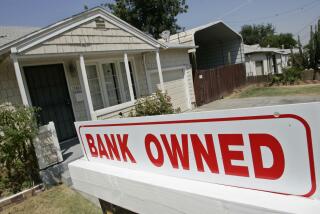Helping homeowners
- Share via
Responding to sky-high foreclosure rates, the Bush administration is attempting to keep some sub-prime borrowers in their homes by persuading lenders to do something they ought to do on their own: modify loans to keep payments on track rather than let current terms drive borrowers into bankruptcy and homes into vacancy.
It seems odd that the government should have to play this role -- after all, in a declining real estate market, lenders lose out in foreclosures too -- but that’s a consequence of how complex the housing finance industry has become. Mortgages can be marketed by one company, financed by a second, packaged and sold to numerous investment groups, then “serviced” by yet another firm. Servicers have been slow to respond to the rising tide of late and missed payments caused when interest rates on adjustable mortgages were “reset.” Most didn’t try to show borrowers ways to avoid the higher rates, and they rarely modified loans to avoid defaults -- in part because they weren’t sure they had the authority to do so.
The president’s plan encourages lenders to help sub-prime borrowers who are current on payments but face interest rate increases they can’t afford, suggesting three options. One is to refinance their loans. Another is to move the borrowers into a new type of loan backed by the Federal Housing Administration. The third is to freeze their current interest rates (which are already a percentage point or more above those paid by prime borrowers) for five years, which should allow them to sell or refinance after the current credit squeeze subsides.
The Bush administration and Gov. Arnold Schwarzenegger, who’s already worked with lenders to freeze rates, deserve credit for setting standards for lenders and loan servicers to protect themselves and their borrowers at the same time. Yes, there are elements of unfairness. Those who benefit the least will be the prudent ones who did not borrow more than they could afford. But with the economy struggling, it’s in everyone’s interest to avert a wave of foreclosures that would damage individual borrowers, their neighbors and a global array of investors in mortgage-backed securities.
Industry and government can still do more. Lenders should reach out to borrowers who have already seen their rates jump, particularly those pushed by aggressive (and sometimes fraudulent) sales techniques into loans they wouldn’t otherwise have accepted. State and federal regulators must strengthen and enforce disclosure and underwriting requirements to make such abuses less common in the future. This includes ensuring that borrowers understand interest rate resets and that lenders consider the highest applicable interest rate, not just the introductory rate, when gauging a borrower’s ability to repay. And regulators must extend these requirements to everyone who markets or initiates a home loan, including independent mortgage brokers. Otherwise, more borrowers may find themselves in the same trap when the housing market falls from its next peak.
More to Read
Inside the business of entertainment
The Wide Shot brings you news, analysis and insights on everything from streaming wars to production — and what it all means for the future.
You may occasionally receive promotional content from the Los Angeles Times.










